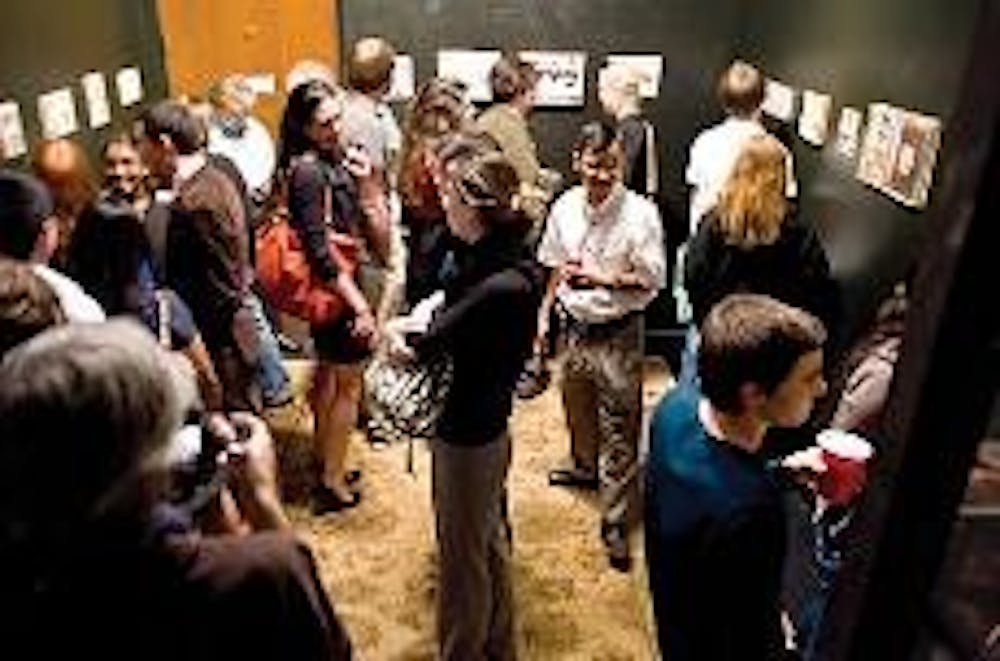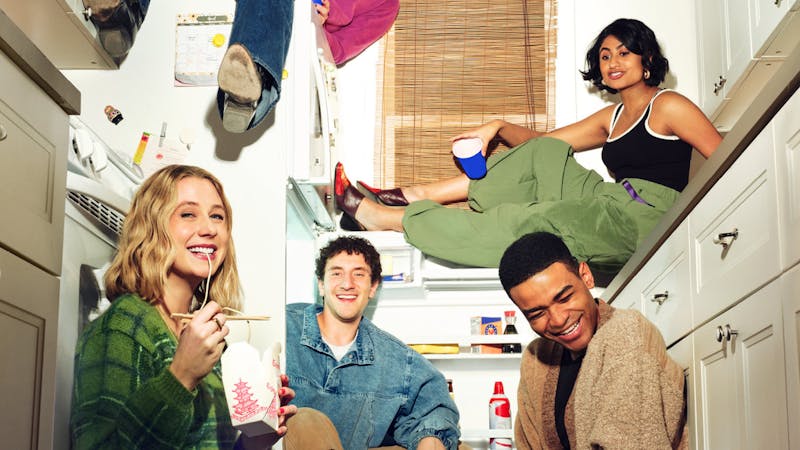The Matchbox

In the gallery's second showing, David Brown's A Thousand Words impressed patrons with a unique, personal approach to photography, framing each picture in hand-crafted journals that depicted everyday life in Mexico.
In the courtyard behind Sewall Hall, hidden out of everyday sight, an institution has emerged that has taken a good chunk of the Rice community by storm seemingly overnight. Much like the university itself, it is smaller than any venue of its kind, yet it produces work that ties the informality of a student-run entity with quality and professionalism. But its location makes it clear that the newest addition to the Rice landscape is not a high quality particle accelerator, nor does it have anything to do with the scientific process. Rather, even in these troubling economic times, funding and support from across campus has been rapidly channeled into something entirely different - a student-run art space housed in a former professor's office, now one of the school's hippest destinations.
Unconventional space
The Matchbox Gallery, so named for its diminutive size by its director, Hanszen College senior art student Logan Beck, began as a whimsical idea when Arts Professor Christopher Sperandio moved out of the space at the beginning of last semester, leaving behind an unoccupied room overlooking the oft-forgotten Sewall courtyard.
"We really didn't have a vision beyond having this terrific space," Sperandio said. "It is small, but just because the space is small doesn't mean the ideas have to be small."
In August, Beck wrote a proposal to convert the empty office into an art gallery, but he had neither the experience usually required to run a gallery nor the traditional room for it.
But in Sperandio's vacated office, where some may have seen an ugly enclosure, Beck saw potential.
"In an art gallery what you want ideally is clean white walls," Beck said. "Right now, they are black and have holes in them."
But the nonconformity of the physical space has been one of the biggest draws for artists searching for patrons and an artistic platform allowing them to experiment with their work.
Before anyone came to see it, though, the concept of the Matchbox lay solely in the minds of Beck and Sperandio. That is, until fellow Arts student Erin Rouse, now Matchbox associate director, submitted her proposal for the gallery's first installation, entitled To Uncle Buddy with Love.
September had just arrived, and the seeds that once were mere ideas began to sprout in soil that turned out to be more fertile than anyone could have imagined. 
One week before Rouse's installment was set to open, the powers-that-be in the Visual and Dramatic Arts department contacted Beck. They had heard of the newly endeavored plans to develop a student-run art gallery, and in a wholly uncharacteristic move, without being asked, had decided to give the Matchbox $1,000 to help with programming.
"I don't know where they found that sort of money, because they are always taking about how they are strapped for cash," Beck said.
The message was received loud and clear, and after scurrying to get rapid approval for a keg of beer, Beck sat back and watched a new Rice tradition born in front of his eyes.
And so the Matchbox was born.
Creating tradition
Irony in its purest form, Rouse had been experimenting with balloons and party decorations for some time, and the Matchbox's first exhibit featured an installation that depicted a broken-down party scene, remnants of a comically sad gathering.
Deflated balloons hung from the wall with strings of party food scattered about, making it look as if she and Beck had met in the Matchbox for days without a trashcan. And with the black walls engulfing the undersized gallery, the scene inside proved the antithesis of the excitement brewing outside.
"They weren't really sure what to think or expect," Beck said. "Here is this little room filled with balloons, and all these people talking about art."
With KTRU broadcasting live, free Lonestar on tap and tons of curious people filling the courtyard, it was perhaps the first time a group of students had gathered at Rice to hang out, drink and have some fun through the medium of art.
"It is interesting to see how non-artists respond to the art," Rouse said. "Art is not necessarily for artists exclusively. I noticed that the draw wasn't just students. It was also faculty and professors and community members. It was really surprising."
Via word of mouth, e-mail and strategically placed posters, the Matchbox - quite literally a hole in the wall - attracted a sizable crowd again for its November showing of alumnus David Brown's installation entitled A Thousand Words. The Matchbox had clearly tapped into a niche that badly needed attention, and it could not have been more satisfied with the results.
The second showing brought with it even more good fortune, though. Along with a new rug that was donated by an impressed Arts professor, Beck again received news of more funding for his idea-turned-instant-sensation. This time, it was not just a group of Arts professors that applauded his efforts, but rather the committee in charge of the Envision Grant, competitively rewarded to a proposal that is aimed at positively impacting Rice or the community.
The Matchbox now had funding for new lights and multimedia equipment for future shows, along with some rainy-day funds, but the grant also clearly meant much more.
"It was a really happy day when I found out that I got the grant," Beck said. "What it means is that not only is this something that the students are behind, but also that Rice sees this as something that needed to happen. And its success speaks for itself."
A lasting presence
With the gallery's newly assured financial longevity and a group of excited students anxiously awaiting the next showing, Beck began taking proposals for the remainder of the year, and for the first time he learned another necessity of the trade - sending rejections.
The proposals began pouring in en masse from artists across campus and Houston, and in that process Beck began seriously deliberating the creative future of the Matchbox.
"I want it to be a space where young artists who never have showed before can experiment and see how their work stands in a small space," he said. "It is unpretentious like that. We don't care if it is balloons or paintings." 
But another aspect of his decisionmaking showed perhaps the most unpretentious face of the gallery. Beck decided that in April, when the Senior Art Exhibit is to showcase the department's graduating works, he will invite a group of art students from the University of Houston to set up shop in the Matchbox.
"To do it during the senior exhibition is brave and exciting," Sperandio said. "We don't know what kind of work they will bring over here. Some of it might be better. I hope some of it is better; it will be a great learning experience."
It will also mark a unique collaboration between two departments that differ wildly in size and make-up. But wildly different is what the Matchbox seems to do best, a formula that is attracting crowds to a new type of gathering at Rice - one that could daringly infuse an academia-and-drinking culture with a little, well, culture.
Though black gold seems to be rushing out of the previously untapped art space in the form of student and faculty support, the seemingly secure future of the Matchbox still remains sensitive to present changes.
Beck is still looking to ensure long-term sustainability with an endowment, along with short-term utility by adding new lighting. Additionally, he hopes to facilitate future transfer of directorship, an opportunity that will undoubtedly invigorate the art department by giving undergraduates the opportunity to have experience running a gallery by the time they graduate.
However, there exists one pillar upon which the Matchbox's future will undoubtedly rest.
"As long as it's in the hands of the students, whichever way it goes, it will be fine," Beck said. "That is the main idea - student run."
It's a sentiment that is echoed by professors alike.
"I knew that I didn't want faculty deciding what should be showing in that space," Sperandio said. "The whole idea is that it is a laboratory for visual creative experimentation."
But if the success it has endured continues, the Matchbox may be much more. It may be the legacy of a small idea like those that preceded an undergraduate pub, an intercollegiate cycling competition or running naked through campus twice a month. For certain, it has already moved Arts and non-Arts students, along with Houston community members, to take part in a school tradition never before realized - one in which people can eat, drink and enjoy some art.
More from The Rice Thresher

Andrew Thomas Huang puts visuals and identity to song
Houston is welcoming the Grammy-nominated figure behind the music videos of Björk and FKA twigs on June 27.

Live it up this summer with these Houston shows
Staying in Houston this summer and wondering how to make the most of your time? Fortunately, you're in luck, there's no shortage of amazing shows and performances happening around the city. From live music to ballet and everything in between, here are some events coming up this month and next!

Review: 'Adults' couldn’t have matured better
Sitcoms are back, and they’re actually funny. FX’s “Adults” is an original comedy following a friend group navigating New York and what it means to be an “actual adult.” From ever-mounting medical bills to chaotic dinner parties, the group attempts to tackle this new stage of life together, only to be met with varying levels of success.

Please note All comments are eligible for publication by The Rice Thresher.